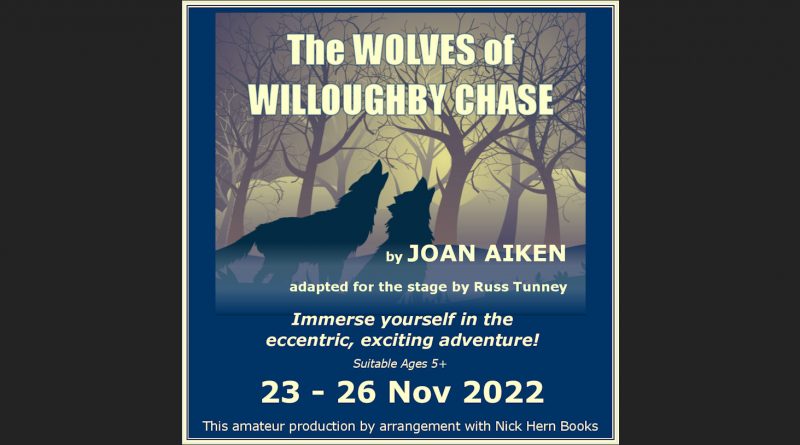Wolves of Willoughby Chase Review by Jo Genesius
This fantastical production of Joan Aiken’s The Wolves of Willoughby Chase, adapted for the stage by Russ Tunney, and set in an alternative nineteenth-century England in the reign of King James the Third, was vividly brought to life by BCP under the able direction of Clare Lester. The script allows great flexibility in the transfer from page to stage and this production was very imaginative.
It is very much an ensemble piece, with 11 actors playing 16 named parts, and the rest of the narrative delivered by any number of cast members in the manner of a Greek Chorus. The cast worked together very well, picking up cues from one another very slickly. The set was fairly simple, with a window and door (to a cupboard replete with secret passage), Simon the Goose Boy’s barrow, and a number of brightly coloured children’s letter blocks, which were used in many creative ways throughout the play, including as a train, a carriage, a bed and seats.
The story follows the trials and tribulations of Bonnie Green and her cousin Sylvia, ably played by Imogen Treadwell and Katy Roberts, as they try to escape from the clutches firstly of their governess (and fourth cousin once removed) Miss Letitia Slighcarp, played by Ian Nutt (as the script directs the part should be played by a male actor), and schoolmistress Gertrude Brisket, played by Hilary Beaton. Bonnie was a strong character, very much in command of the situation, whereas Sylvia was more timid and downtrodden, and this came through well in Imogen and Katy’s portrayals. Ian and Hilary both played their parts excellently, managing to blend humour with malevolence. Miss Slighcarp was played androgynously, but never slipped into pantomime damehood, and Ian coped admirably with a very tall wig.
One of the more sinister moments was when Mr Josiah Grimshaw, adeptly played by Nik Lester, offered first chocolates, then a blanket, and finally some cheese to a frightened Sylvia on the train, in the midst of night and surrounded by the howling of the wolves. Only later did we discover Grimshaw’s part in Miss Slighcarp’s dastardly plot, but right from the start, Nik’s acting set up this character for later nastiness.
Helping Bonnie and Sylvia are James, Sir Willoughby’s butler, and Simon the Goose Boy, respectively played by Chris Brant and Martin Crook. It is always excellent to see new talent in BCP, and this was the first production for both Chris and Martin, along with Sian Gibson, who played Emma. All three of them fitted into the ensemble cast well, very much at home on the stage of The Mill. Simon was of course accompanied by his geese, ably moved and voiced by Helen Williams. It is amazing how emotive a goose can sound. There wasn’t a warning in the programme for those on the front row, however, as the geese had a go at pecking their feet!
Adrian McGlynn was suitably over the top as Sir Willoughby Green. As with several cast members, Adrian had more than one character to play, and lawyer Mr Gripe contrasted markedly with Sir Willoughby: Adrian playing both with his usual aplomb. Jem Turner, another familiar face on The Mill stage, played not one, but two doctors, again with very different characters.
Given the fairly minimal set, it was lovely to see the play as a piece of physical theatre. The chorus (i.e. all cast who were not on as characters at the time) portrayed cobwebs in the secret passage, trees in the forest around Willoughby Chase, and even the buildings of London. Bonnie and Sylvia believably skated along the frozen river, and watching the passengers in the carriage apparently bumping along with James at the reins was very convincing. There were some excellent moments without dialogue, such as Nik eating chocolates, Helen being the luggage rack and, hilariously, setting Aunt Jane’s rooms on the fourth floor and watching the cast ‘climbing’ four flights round and round one of the curtain legs.
It was not always obvious whether the production was straying from the original script or not, but there were some very amusing moments, such as a Scooby-Doo allusion ‘I’d have got away with it if it wasn’t for those pesky geese!’, and when the cast broke the fourth wall when Adrian, on stage as Mr Gripe, suddenly needed to be on stage as Sir Willoughby. Clearly quite intentional, and a clever piece of stagecraft. One of the high points for me was the flawless recitation of the ‘cheese alphabet’ by the cast at Gertrude Brisket’s (Brie-sket’s?) school: a rare moment for well-deserved spontaneous applause.
Finally, the production would not have its vitality without sound, lighting, props and costumes. The soundscape was very important in creating just the right atmosphere – eerie, uncertain and at times otherworldly – and the lighting evoked the forest at night and the secret underground passage to the brightly lit interior scenes.
Oh, and the wolves? They did not figure overly much, except in the background, but it must be said that the ensemble cast are skilled at howling. An excellent job all round.
Jo Genesius

